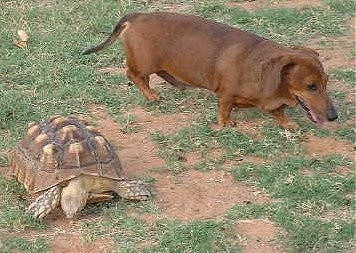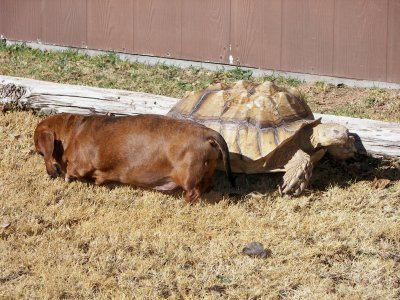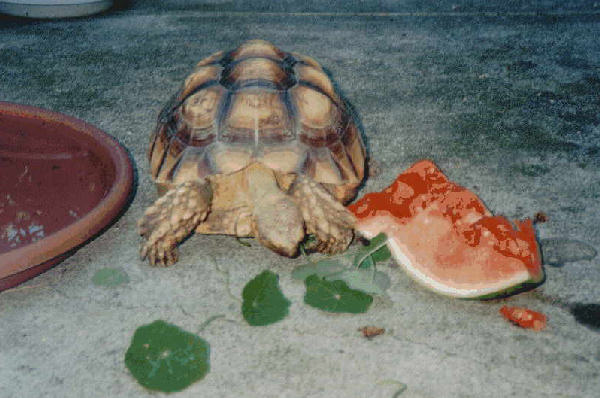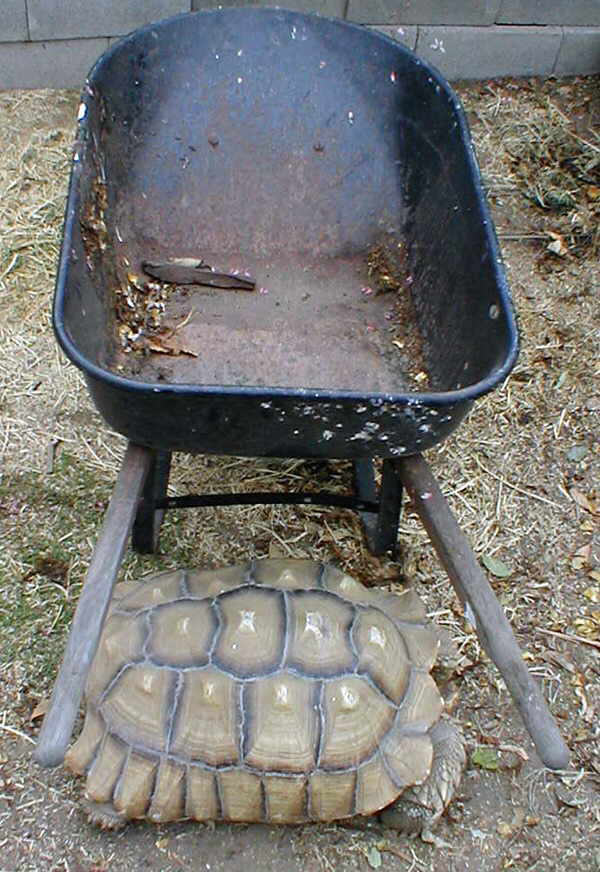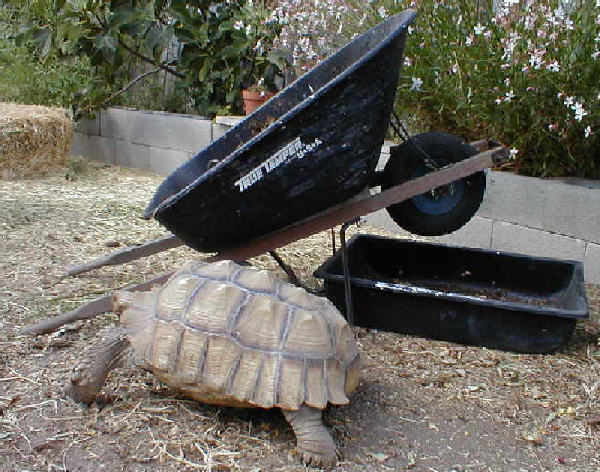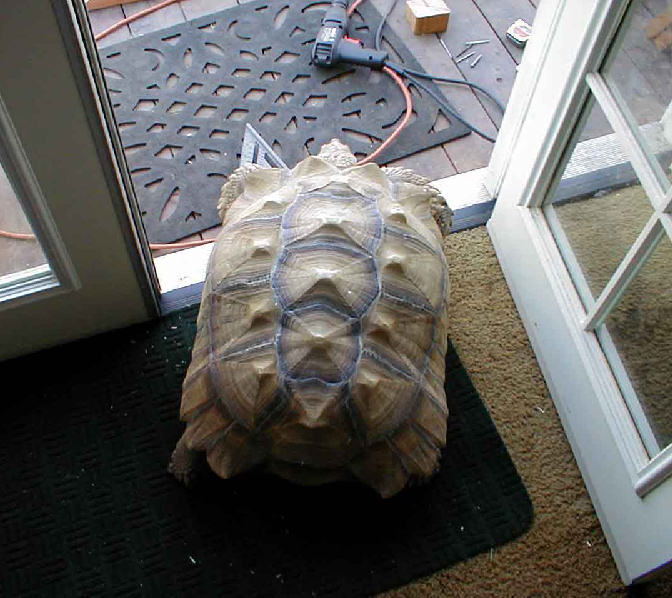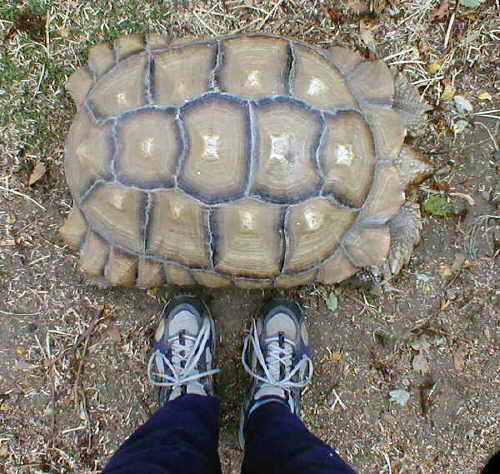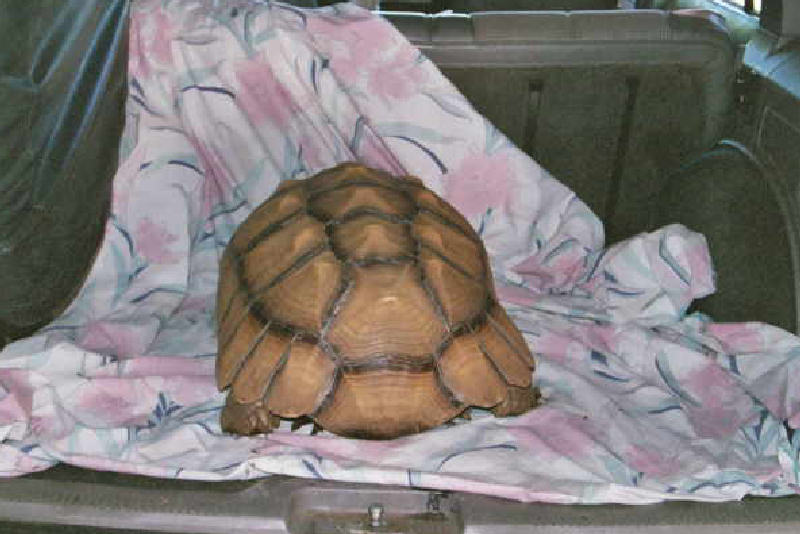
Melissa
Kaplan's
Herp Care Collection
Last updated
January 1, 2014
Sulcatas Get Big. Fast.
Even if you do a crappy job caring for them.
©2006 Melissa Kaplan
It has been a decade since I wrote my Sulcata Tortoises article. Since the article was first published, more people got those incredibly cute little sulcata babies because they believed the pet store employee who insisted that they don't grow very fast, or the idiots out there who still insist that you can control reptile growth by keeping them in small enclosures, or who believe it is perfectly all right to starve giant species into slow growth rates.
And then there are all the people who got them because they just did not believe how big sulcatas get. They read the numbers
The sulcata is the largest of the African mainland tortoise, with specimens easily reaching 24-30 inches
(60-75 cm) in carapace length and 80-110 pounds (36-50 kg).
but still don't get it or can't visualize it.
Some friends of mine did not go out and get cute little baby sulcatas. They did, however, take in some that had been abandoned--dumped on a roadside to fend for itself, in the case of Texas one pictured below, and dumped on a chelonian rescue, in the case of the California one pictured below. Both sulcatas showed signs of having been improperly cared for prior to ending up with my friends, who undertook to care for them properly.
|
Gunshot Destiny, the sulcata, was found wandering the roads near Midland TX several years ago. This photo was taken in September 2002. |
Here's the same tortoise and same dog (Diogee, a dachshund battling Cushing's, an autoimmune thyroid disease causing, among other things, undesirable weight gain) in January 2006. Destiny's shell is still pyramidded, as it was when she was first taken in by vet tech Jan McArthur, but is doing extremely well now.
|
||
|
This is Buddy, one of two stunted, heavily pyramidded sulcatas dumped on a Sonoma County chelonian rescuer in 1997. Buddy was taken in by a friend of mine who helped the rescuer from time to time care for her 50+ chelonians. |
Here's Buddy next to my extra large (tall and long) Doberman goddog, Sidney, who weighed about 100 pounds when this photo was taken. Buddy wasn't intimidated by Sidney at all, and would cheerfully bulldoze into him when trying to get to Sid's food or treats.
|
||
|
To give you some sense of size, here's Buddy, also in 2002, in front of a regular sized wheelbarrow.
|
Here's the side view of Buddy and the barrow. |
||
|
Here's Buddy exiting the house, after making his way up the deck steps (see photo on the right). On day, he broke into the house when no one was home, made his way all the way through the house into the master bathroom, where he knocked the door closed behind him. He then spent several hours battering and clawing the door, the walls and the baseboard, trying to get out. Fortunately, his 'mom' is very good with DIY home building and repair.
|
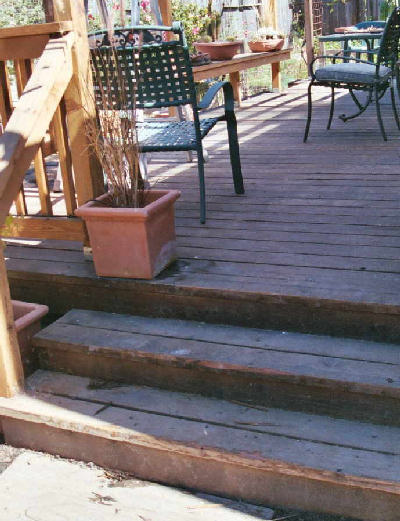 |
||
|
Also from 2002, my friend takes a few last photos of Buddy. With her husband physically impaired from a stroke, she can no longer handle the 80 pound Buddy on her own. Fortunately, there is a resource here that wasn't already overcrowded with everyone else's dumped sulcatas, a private zoo and breeding facility that supports itself by giving guided tours of its African wildlife. |
Bye-bye, Buddy, bye-bye... |
Here are growth and weight charts for three rescued sulcatas, including Buddy.
Fantasy Tortoises
I wrote
the following in 2000 or so, in response to a tortoise forum post from
a woman whose husband desperately wanted a couple of baby Aldabran tortoises
to keep. At home. In the mountains of Colorado. It applies to anyone thinking
of getting a giant long-lived species of any animal...but especially giant
tortoises.
How are you and your husband doing financially? Your Aldabran is going to outlive both of you (100-150 years) - and possibly your children, too, assuming they are even willing to take over the care and keeping of your Aldabran once you two, er, leave this mortal coil. So, ignore the snickers of your attorney, and set up a trust fund for the care of your tortoise to ensure someone will care for it properly once you two are no longer around.
Practically speaking, it is likely that you are not going to be able to perform all the daily care tasks the tortoise will need for sometime before you die, and so you also need to start stashing away some money you can use to pay for someone to come in and provide the daily care. Of course, having the tortoise rules out moving to a smaller place. And what will happen if the one of you who survives the other ends up needing to live in an assisted care facility? You can't take the tortoise with you.
These elder care/financial responsibility questions need to be discussed with your children, too, if you are expecting them to take over the tortoise once you are gone or no longer able to care for the tortoise. And, of course, if your kids aren't married right now, or you don't have kids yet, whatever your kids do promise you may change if they end up getting married to someone who puts their foot down about this and refuses to be saddled with a "white elephant" weighing 100-200 pounds or more.
I haven't even touched upon the agitation and digging and scratching and ramming behavior of tortoises during breeding season or when they're bored, or just want to see what's over...there. No matter how smart they are, they just don't seem to get it that glass and walls are impermeable and so will keep scratching and pounding against them, trying to get outside on days when it is still too cold to go outside, or inside when they want to come in. With my 12" long 12-15 lb desert tortoise, this behavior is merely annoying, but okay so long as I get the sliding glass door closed before he tries to rip through the screen door (again). Better make sure any accessible glass (and floor-length mirrors) are thick and tempered - I'd hate to see a highly motivated Aldabran covered in shattered glass of any type.
Here's a way you can get a taste of what it will be like having one headstrong--not to speak of strong--Aldabran hanging out in your house or patio:
| 1. |
Buy the largest dogloo you can find - 39.8x39x30.5 and fill it with 100 lb of concrete. Once dry, empty out the concrete and place it on a wooden platform to which you've attached some casters. You now have a mass about the weight of an adult sulcata. Note that Aldabran tortoises are bigger and heavier.
|
||
| 2. |
Now, shove that baby around your house. Let it ram into walls, into your greataunt Fannie's antique end table you inherited from your mother, and don't spare the children's toys! Outside, ram it into the outsides of doors, the patio furniture, and your Weber™ grill. Got flowers? Be sure to roll it over your bedding plants, too. Got young kids or grandkids? Great! Be sure to ram the 'tortoise' into them, too.
|
||
| 3. |
Okay! That was the easy part! Now, remove the 'tortoise' from the wooden platform...or, to prevent permanent damage to your floors, remove the casters from the platform, so that the wood sits on the floor with the 'tortoise' on top of it. Now, make that tortoise go where you want it to go. It's easy to move an 80+ pound tortoise in the direction it already wants to go, but if you need to make it go somewhere it doesn't want to go, well, you have to push.
|
||
| 4. |
Even when the tortoise gets too big to pick up and carry, you will still have to be able to pick it up, or tilt it safely to once side, to check its carapace to make sure everything looks nice and healthy down there, or, heaven forbid, have to treat a raging case of shell rot because you couldn't move it off its urate-soaked bedding during the winter when it was bedding down in your basement.
|
||
| 5. |
Now, like all reptile owners, you need to have a reptile vet knowledgeable about the care, diagnosis and treatment of reptiles, but in your case, you need a vet who has studied up on the giant tortoise species. Of course, if your vet isn't also a mobile vet, or doesn't as a rule make house calls ("large animal vet" typically means horses, cows, and other farm stock, not sulcatas, Galapagos and Aldabran tortoises, so don't go making assumptions about housecalls), you are going to have to get the tortoise into your care and drive it to your vet. Don't have a car big enough for transporting your tortoise? Well, you're just going to have to go out and buy one. After all, you cannot count on being able to find a friend who has one and can drive you and your tortoise when you need a ride to the vet, and you sure as heck can't take the tortoise in a taxi or bus.
|
If, as probably will probably happen, since I'm guessing you aren't heating your home to the ambient air temperatures found on Aldabra in the Indian Ocean, your tortoise gets respiratory infections during the winter, are you prepared to administer necessary antibiotics, and increase the heating of your home so that it remains in the low to mid 80s day and night? Might want to calculate the cost of doing so before saying yes. You'll find an article on Calculating The Cost Of Electricity at my site.
You might also want to read my So, you think you want a reptile? article. The bottom line, especially when it comes to the giant species of reptiles or any other taxa, just because someone is out there breeding them and selling them doesn't mean they make suitable pets. When researching my article on sulcatas, I interviewed the man who first nailed down how to breed sulcatas in captivity and successfully incubate the eggs. He told me that, had he only realized what would result from the publication of his article--that people would use the information to breed the species for the pet trade, he would never have submitted his article for publication. The information is vital for zoos and researchers who need to know as much as they can to safeguard the species. But sulcatas, and other giant tortoise species, are at as much risk from pet owners who, despite all good intentions up front, really do not understand the scope of what they are taking on when they first buy that cute, little handful of shelled beauty.
Turtle Rescue of Long Island is, like a growing number of chelonian and herp rescues, ending up with dumped sulcatas whose prior owners didn't bother doing the research necessary up front, or decided that it didn't apply to them, or that "grow really fast" really meant "grows very slowly" and so they assumed they had lots of time before their sulcata outgrew their home and needed to be rehomeed (which is wrong on so many levels...). Check out TRLI's Sulcata Challenge for more information and photos.
